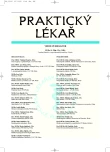Diagnosyis – iron deficiency
Diagnóza sideropenie
Sideropenie je patologickým stavem, který se v populaci vyskytuje relativně často. Nemusí být vždy provázena anémií, ale pouze nespecifickou symptomatologií, a proto není ve své latentní podobě často vůbec diagnostikována. Rizikem deficitu železa jsou zatíženi zejména jedinci, u nichž přirozený přísun železa potravou nepokryje chronické ztráty nebo zvýšenou potřebu organismu. Typickou a nejpočetnější skupinou jsou ženy ve fertilním věku, dále děti, a to zejména kojenci, pubescenti a adolescenti. Právě v těchto skupinách může být latentní sideropenie příčinou řady nespecifických zdravotních potíží a v praxi by mělo být provedeno nejen vyšetření krevního obrazu a sérové hladiny železa, jejichž výsledky mohou být normální, ale i testy, které jsou z hlediska diagnostiky deficitu železa specifičtější a senzitivnější. Jedná se zejména o vazebnou kapacitu transferinu pro železo, sérový feritin, eventuálně solubilní transferinový receptor. Vyšetření, jako hladina erytrocytárního protoporfyrinu, aspirace nebo biopsie kostní dřeně s barvením na železo by měla být zvažována až v druhé linii u nemocných s již rozvinutou anémií, pokud výsledky standardního diagnostického panelu nevedly k jednoznačnému závěru. Narozdíl od pouhé hladiny sérového železa a krevního obrazu, mohou uvedená vyšetření pomoci i v odlišení anémie chronických chorob od sideropenické anémie.
Klíčová slova:
sideropenie, anémie, feritin, celková vazebná kapacita transferinu pro železo, solubilní transferinový receptor, anémie chronických chorob.
Authors:
L. Raida
Authors‘ workplace:
Lékařské fakulty Univerzity Palackého a Fakultní nemocnice Olomouc
; Přednosta: Prof. MUDr. Karel Indrák, DrSc.
; Hemato-onkologická klinika
Published in:
Prakt. Lék. 2007; 87(7): 432-435
Category:
Diagnostis
Overview
Iron deficiency is a relatively common pathological state in the population, but does not always manifest as anaemia but rather as non-specific symptoms, and is, therefore, often not diagnosed in its latent form. Individuals are at risk of iron deficiency when their natural intake of iron is lower than a chronic loss of iron or is simply not adequate due to the body’s increased demand for iron. The most typical and major group are women of fertile age followed by infants and some individuals in puberty and adolescence. The majority of their non-specific symptoms may be explained by latent iron deficiency. More specific and sensitive tests for iron deficiency should be carried out in clinical practice in these groups in addition to the evaluation of blood cell counts and serum iron levels because of the usually normal, and therefore confusing, values obtained by these two tests. In particular, tests for transferrin iron-binding capacity, serum ferritin, and perhaps soluble transferrin receptor. Methods such as the evaluation of erythrocyte protoporphyrin, bone marrow aspiration or biopsy stained for iron should be considered as a second approach for patients with developed anaemia if the results of the standard diagnostic panel are not conclusive. As opposed to the evaluation of just the serum iron level and blood cell count, the further tests outlined can aid in the distinction between chronic disease anaemia and iron-deficiency anaemia.
Key words:
iron deficiency, anaemia, ferritin, transferrin iron-binding capacity, soluble transferrin receptor, anaemia of chronic disease.
Labels
General practitioner for children and adolescents General practitioner for adultsArticle was published in
General Practitioner

2007 Issue 7
- Metamizole at a Glance and in Practice – Effective Non-Opioid Analgesic for All Ages
- Memantine in Dementia Therapy – Current Findings and Possible Future Applications
- Advances in the Treatment of Myasthenia Gravis on the Horizon
- Possibilities of Using Metamizole in the Treatment of Acute Primary Headaches
- Hope Awakens with Early Diagnosis of Parkinson's Disease Based on Skin Odor
Most read in this issue
- Acute neuroborreliosis
- Diagnosyis – iron deficiency
- Assessing oral health-related quality of life in Czech population
- Psychological aspects of acute pain
